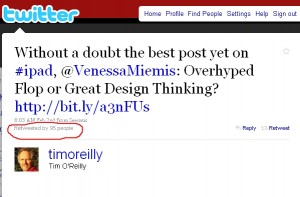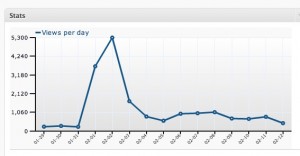How do we create value when we’re busy tweeting, blogging, reading and writing? I have been arguing that to create value from information, we need to have systems in place that allow us to aggregate, filter and connect information – and that this is true for people, and for business models. These are the things that go on all the time behind the scenes when people are creating blog posts, and I thought it would be interesting to see how this actually happens.
Shortly after the unveiling of the iPad, Venessa Miemis wrote a post called ‘iPad: Overhyped Flop or a Case of Great Design Thinking?‘ Venessa has a distinctive talent for writing about complex topics in an integrative and creative manner, so I thought it would be interesting to ask her about how she put this post together.
Tim: What resources did you use to collect & keep track of all of the discussions surrounding the iPad?
Venessa:Ever since I started blogging regularly, starting in November 2009, I’ve used Twitter as my main tool for collecting resources. It’s taken months to build a network, but it’s been well worth it. I’m very satisfied with the quality of tweets that pass through my stream. For the iPad post, it wasn’t too hard to find the articles – the Twittersphere was abuzz with speculation and opinions about the iPad in the week leading up to the keynote and in the days following it.
I saved most of the articles that came from a media outlet (Wired, New York Times, engadget, PopSci), and then paid attention to the articles by individual bloggers that were getting RT’d and referenced the most. I also used the #iPad hashtag to search what people on Twitter outside my immediate network were saying. I saved all of these links into delicious.
Comment: Twitter ended up acting as both an aggregation tool and a filter. The assumption behind Venessa’s strategy here is between the tweets from own network, which is large, and through searching that she would find most of the relevant commentary on the iPad. The filtering aspect is interesting – when we choose to follow someone on twitter, we are in part relying on them to choose the best things that they encounter to tweet about. So our network is doing a lot of the work in terms of filtering.
Tim: Did you use any tools to sort out the themes, or did you just work it out in your head?
Venessa: The themes emerged from the posts themselves. As I read through them, it seemed the implications of the iPad could be framed around three main areas: business, education, and leisure.
Comment: Here’s where I’m a lousy interviewer, because this is the key part of the process and I didn’t ask very good questions here (but see Venessa’s comment for more). But the value in the post is that it did not simply aggregate all the online discussion about the iPad. After collecting all the information that she could find, Venessa selected further by picking what appeared to be the key posts about the iPad.
Then, she connected up ideas by grouping them into themes. For me, this is the entire reason that the post works so well – it is the creative connecting. It’s also interesting that Venessa covers this in one line. It’s very typical that this step is hard to describe. We often talk about themes ‘emerging’ from our collected reading. As I’ve said before, connecting ideas is the fundamental creative act – and when you read the post, you can see how Venessa did this extensively in writing it.
After we connect up ideas, then we have to connect our ideas to people to get them to spread:
Tim: How did you promote the post?
Venessa: At 2:06pm on Feb 1st, I tweeted this:
At 5:03pm on Feb 1st, Tim O’Reilly tweeted:That day, there were 3,672 visits to the site. The next day had 5,297. The next day had 1,690, and since then there have been between 700 – 1,000 visits daily. The post has received 21 trackbacks, and 121 comments (although I answer almost every comment, so you can subtract that by half). It was one of the top 20 posts on wordpress.com on February 3rd.
At the time of this writing, bit.ly shows the link has been clicked 7,785 times.
I also just found out that the post was mentioned on Leo Laporte’s “This Week in Tech” podcast on February 7th by Baratunde Thurston.
Tim: Can you track how the idea travelled?
Venessa: With over 1.4 million followers, it’s clear that Tim O’Reilly’s influence is far-reaching. Normally when I post a new article, I’ll get around 400-700 visits. Last week I had over 14,000.
I did get a big influx of new followers on Twitter (250+) within those first 48 hours, but I don’t know what percentage of that translated into new blog followers.This has been a really interesting experience, and more a display of the power of influence than anything else. I wouldn’t say the quality of that post was particularly higher than any others I’ve written. It was just super topical and given exposure by a highly influential person within the tech community. In order to get a post go that viral again, I may just have to be patient until Steve Jobs builds hype for whatever comes after the iPad.
Oh, and another thing to mention, which I thought was interesting – though I received 10 times the amount of traffic, I only got about twice as many comments…..so maybe 14,000 visits and only 50 comments. which to me says a lot about the amazing community that has grown around the blog. Though I may not get huge daily numbers with my traffic, a lot of people comment and engage and interact, and that’s what has made the blog so interesting. The posts are primers, but the conversations that follow is where a lot of insights and tips come in. So though I saw the power of influence via traffic, the quality of traffic I already had is unmatched.
Comment: There’s obviously a lot to say about connecting up ideas and people here. First, the traffic spike from Tim O’Reilly came as a result of the quality of idea connections in the post. There were hundreds (probably thousands) of posts about the iPad that week. Venessa’s did well because of the synthesis. That’s what led to the post getting into a traffic network with so many people in it.
I think this sheds some light on the question of the value of transient traffic. Venessa’s blog regularly gets a lot of very good, thoughtful comments as she mentions. This is because of the community that has built up around the blog (connecting ideas to people!). Because that community was already there, I think it made it easier for her to capture some value from the huge spike in traffic that she got. Double the number of comments is actually pretty good – it is sure more than you’d expect if transient traffic is ‘worthless’. Same with an increase of 250 people following on twitter. I suspect that regular RSS feed readers probably took a spike too. If you’re creating good intellectual value, it increases the connective value of transient traffic.
Finally, a lot of people talk about information aggregation as something that creates value in and of itself. Because it is a relatively easy thing to do, this why a lot of people dismiss Amazon and Google as ‘merely aggregators’. But the value doesn’t come from simply aggregating. The real value comes from aggregating information, filtering it effectively, and then creatively connecting ideas.
All three parts of the process must be done well in order to create value from information. I hope that this behind the scenes peek at the making of ‘iPad: Overhyped Flop or a Case of Great Design Thinking’ provides some insight into how the process works.
This is a reprint from The Innovation Leadership Network blog written by Tim Kastelle, John Steen and Mark Dodgson. We are all members of the Technology & Innovation Management Centre in the School of Business at the University of Queensland.


